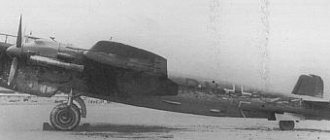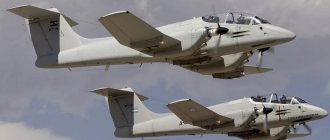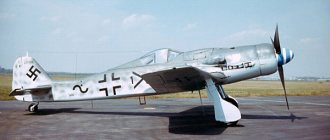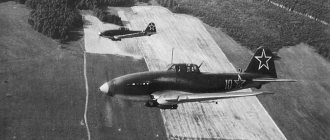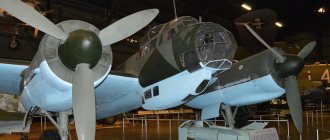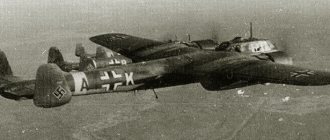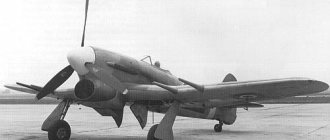Home » Unrealized aircraft projects. » Tomashevich's planes. Experienced front-line fighter I-110
Unrealized aircraft projects.
boroda 09/14/2020 1214
16
in Favoritesin Favoritesfrom Favorites 9
At the turn of the early forties, one of the main problems that arose in the development of new aircraft was the issue of creating a suitable propulsion system. Quite often, many promising projects were closed due to the lack of a finished production engine. But more often than not, the development progressed in such a way that the existing problems were complex in nature, which significantly complicated the implementation of the original plans. There were many similar cases in the history of Soviet aviation. One such illustrative example is the development of the I-110
. It was created at a very difficult time for our country. The project initially contained quite interesting ideas. One series of difficulties that arose and a combination of circumstances did not allow us to complete everything to its logical conclusion and launch the aircraft into mass production. Let's take a closer look at what this fighter was like, how its development took place and whether it had any prospects. This review will be published in two parts. The first publication will be devoted to the initial stage of development, and the second will highlight the design features of the fighter, the tests carried out and sum up the results of the program.
Experimental prototype of the I-110 fighter
The history of the creation of the MiG-23 fighter
In 1961, in the experimental design bureau No. 155 (A.I. Mikoyan), work began on a new fighter designed to replace the MiG-21 fighters in the army. The new aircraft received the designation MiG-23 .
Initially, the MiG-23 was supposed to be a further development of the MiG-21, using some of its design elements. The prototype, designated E-8, was ready by the following year and made its first flight on April 17, 1962 (test pilot G.K. Mosolov). However, the E-8 did not meet the requirements of the new time - it was clear that simply modernizing an existing aircraft could not solve the problem; a fundamentally new solution was needed, or, more precisely, a new aircraft. After the disaster (September 1962) of one of the prototypes, work on the E-8 was completely stopped.
The new MiG-23 was supposed to be an extremely ambitious project - a speed of up to 2,700 km/h, both short- and medium-range missiles, a short take-off run, the ability to be used as an attack aircraft... In general, the requirements were mutually exclusive and the designers had a lot to think about.
G.A. Sedov was appointed chief designer of the MiG-23 project. The general management was carried out by A.I. Mikoyan, and after his death - by R.A. Belyakov. The power plant was supposed to use the RD-36-35 engine, which was tested in June 1966 on the experimental MiG-21PD (E-7PD). With the advent of the engine, the previously stalled work began at double speed. Already on April 3, 1967, the first version of the MiG-23 (MiG-23PD or “product 23-01”) with a delta wing and two RD-36-35 engines took to the skies.
Drawing of the MiG-23B fighter
The second prototype (“product 23-11”) had an important, as it eventually turned out, defining difference - a wing of variable geometry (sweep), which made it possible to solve the problem of “inconsistency” of Air Force requirements. Depending on the task, conditions or flight mode, the pilot could choose the optimal configuration of the wing - “fold” or, conversely, “open” it, thereby changing the takeoff, landing and maneuvering characteristics. The new aircraft made its first flight on June 10, 1967 (test pilot A.V. Fedotov). The choice settled on this version of the fighter.
Another important novelty of the MiG-23 was the S-23 weapons control system, developed specifically for the MiG-23, and providing all-angle interception of air targets both in free space and against the ground. The new weapons control system also included the latest K-23 medium-range air-to-air missiles - the first medium-range missiles for Soviet combat aircraft.
Two years later, in 1969, mass production of the MiG-23 modification “C” was organized at Moskovsky, however, modifications to the fighter and the state. testing continued even after the vehicle entered service with the troops - until 1973. For the enormous amount of work done and the introduction into the production of the wing of a fundamentally new design, variable geometry, TsAGI specialists were awarded the USSR State Prize in 1975.
Production of MiG-23 aircraft continued until 1985, a total of 3,630 “linear” fighters (including all modifications) and 769 training aircraft were manufactured.
MiG-23 fighter model
At the time of its appearance, the MiG-23 was superior (or not inferior) in performance to all Western aircraft of the same age, but differed favorably from the “specialists” in its versatility - an interceptor in its main “profession”, it also coped well with the role of a bomber, moreover, in its design had good potential for further upgrades. Although in the Russian Air Force, the MiG-23 was already in the early 1990s. were decommissioned (they served in the air defense until 1999), the reason for this was not the obsolescence of the aircraft, but only the presence in the Air Force of more advanced and promising aircraft such as the MiG-29 and Su-27. Without them, even by the beginning of the 21st century, the latest modifications of the MiG-23 would have represented a very formidable fighting force.
The aircraft was in service (except for the USSR) in Libya, Angola, Sri Lanka, Cuba, Yemen, Zimbabwe, Namibia, Ethiopia, Syria, Algeria, Egypt, Iraq, North Korea, Sudan, Bulgaria, East Germany, Czechoslovakia, Poland, Romania.
Frontline aviation
Frontline aviation
The Su-37 fighter represents a deep modernization of the well-proven Su-27. Its design managed to combine the latest achievements in the field of aerodynamics, electronics and engine engineering with well-developed design elements of combat aircraft of the late 1970s.
Su-37 fighter
Ship-based fighter Su-27 K
Work to improve the Su-2 7, the most maneuverable fourth-generation fighter in the world, began at the design bureau of P.O. Sukhoi back in 1977. On its basis, the promising Su-27 fighter, the multifunctional Su-27M, the carrier-based Su-27K and the strike Su-34 were created.
Not content with this, our specialists began developing the Su-37. This is an aircraft of a unique design - a triplane with a front horizontal tail, which significantly increases the combat characteristics of the aircraft, reduces loads and increases comfort for the crew in bumpy conditions.
Another innovation that has radically increased the maneuverability of the Su-37 is engines with rotary nozzles. This engine design allows the aircraft to literally turn “on its heel” and easily maneuver at extremely low speeds, when conventional aerodynamic control surfaces are no longer effective.
Fighter-bomber Su-24
To accommodate missile weapons on the aircraft, 12 external hardpoints are provided. Air-to-air missiles of various ranges are used to engage air targets. When using the Su-37 as an attack aircraft, they are replaced by Kh-29T air-to-surface guided missiles with television guidance or X-29L with laser guidance, Kh-31P anti-radar missiles or Kh-31A and Kh-35 anti-ship missiles. In addition to guided missiles for various purposes, the aircraft can also carry aerial bombs and other payloads.
The Su-30 fighter-bomber is a multi-role aircraft that can be used, for example, as a long-range interceptor. In addition, the Su-30 is used as an attack aircraft and fighter.
The aircraft's design uses composites and high-strength aluminum and titanium alloys. The power plant consists of two turbojet engines. They provide a flight range of 3000 km without refueling.
The Su-30 fighter-bomber is equipped with a built-in 30-mm PP-301 cannon, as well as missile weapons. Depending on the type of combat mission, the type of missiles may change.
The Su-34 front-line bomber is designed for targeted destruction of targets with missiles or bombs in any weather, both day and night. This aircraft is intended to replace the Su-24 and Su-24M bombers, which have already exhausted their resources.
Since the Su-34 is capable of covering intercontinental distances, the designers took care of convenience for the pilot and navigator-operator. Pilots can now stand up and stretch during multi-hour flights. They have a kitchenette, air conditioning and a toilet at their disposal. For the safety of the crew, the cabin is an armored capsule made of titanium and unbreakable glass. The possibility of ejecting the crew is provided.
Fighter-bomber Su-30
The vehicle is equipped with modern electronic equipment, in particular an active safety system, which allows it to automatically follow the terrain at extremely low altitudes at speeds of up to 1,400 km/h. The fuel supply in the internal tanks is enough for a 4100 km flight. In addition, the aircraft can refuel in the air.
Su-34 front-line bomber
S-37 "Berkut". At first, the plane seems to be flying backwards. This impression is created by forward-swept wings. German designers tried to make the first such aircraft at the end of World War II. But they didn’t succeed - the so-called divergence interfered: when the speed increased, the car seemed to “kick” in flight.
It was not possible to eliminate this drawback then, since there were no appropriate materials, calculation methods, or on-board computers that would help the pilot cope with the obstinate machine... And the development of the country and the nation took a different path - machines with positive sweep took off into the air - with planes laid back .
Nevertheless, for many years, experts did not give up attempts to create an aircraft with a forward-swept wing. The fact is that such an aircraft, according to calculations, should have excellent lifting force at subsonic flight speeds, which means it should be easy to take off and land successfully, greatly reducing the takeoff and mileage. In addition, the machine is very maneuverable in the air, and is also capable of flying much further than similar aircraft with a conventional wing.
In flight S-37 "Berkut"
In the end, the problem of stabilizing the aircraft in flight was solved with the help of modern technologies. The composite wing is practically not afraid of divergence, therefore, despite the fact that the S-37 “Berkut” is made according to the aerodynamic design “integral unstable triplane”, it flies quite stable. To a large extent, its stabilization in flight is facilitated by the “canard” design, when the horizontal control planes - stabilizers - are located not on the tail, as usual, but in front, almost at the level of the pilot’s cabin. Moreover, for greater efficiency, they, like the keel, are all-moving, while usually only small rudders at the rear of the stabilizer or keel are deflected.
Scheme S-37 "Berkut"
On September 25, 1997, test pilot I. Votintsev took the S-37 into the air for the first time. Tests have shown that the selected aerodynamic design not only provides high flight performance, but also reduces the radar signature of the aircraft. This is also facilitated by the fact that the wing itself is 90% made not of metal, but of composite materials.
Based on the Berkut, the designers hope to create a fifth-generation fighter that will be the best in the world, just as its predecessor Su-27 turned out to be a champion in its class among fourth-generation aircraft.
The MiG-33 fighter was designed in the early 1990s by radically modernizing the proven light front-line fighter MiG-29.
The forward part of the fuselage, including the cabin, is made of aluminum-lithium alloys. This made it possible to reduce the weight of the aircraft and reduce the labor intensity of manufacturing. Composite materials were widely used in the design, in particular, the vertical tail, air intakes, and lining of the power plant compartment were made from them.
MiG-33 fighter
MiG-29. Flight as a couple
The power plant has been significantly updated. The MiG-33 uses modernized RD-33K engines with increased thrust and a fully digital control system.
The aircraft is equipped with new avionics. Thus, the optoelectronic locator provides an increased detection range of air targets, and the aircraft has the ability to illuminate the target with a laser beam. The MiG-33 also uses a highly effective helmet-mounted target designation system, where all data is displayed directly on the transparent visor of the pilot’s helmet.
The built-in armament of the MiG-33 is similar to that of the MiG-29, and consists of a 30 mm air cannon mounted in the left wing.
To accommodate suspended weapons, 9 hardpoints are provided - 4 under each wing and another under the fuselage. At these places bombs with a total weight of 4.5 tons or 8 new RVV-AE air-to-air missiles, as well as aerial bombs with television homing heads or 4 air-to-surface guided missiles can be suspended.
Multifunctional front-line fighter MFI. Its development at the A. Mikoyan design bureau began at the end of 1979.
The aircraft was supposed to be made according to the canard aerodynamic configuration with a delta wing and a horizontal nose tail. Calculations showed that the new vehicle would have super-maneuverability, the ability to easily overcome the sound barrier, and low radio signature...
The aircraft was demonstrated in flight on February 29, 2000. According to experts, the Russian fighter is superior to the best foreign analogue - the F-22A aircraft.
The maximum speed of the MFI is 2500 km/h, practical range is 4500 km.
Tactical fighter F-22A.
The aircraft, which first flew in September 1990, is designed primarily for air superiority. It has low radio signature, achieved through the widespread use of stealth technology (more on this a little later).
Composite materials are used in the design of the aircraft. The flat lower surface of the fuselage allows the placement of air-to-air guided missiles there. In addition, on each wing there are two additional mounting points for 2250 kg of weapons. Finally, the aircraft can carry about 500 kg of bombs or other cargo inside the hull.
Promising fighter F-22
F/A–18E aircraft landing on an aircraft carrier
To date, two prototypes have been built with different propulsion systems. Equipping troops with these fighters is expected in 2004.
Carrier-based fighter-attack aircraft F/A-18E and F/A-18F. The development of two modifications of the carrier-based fighter-attack aircraft began in 1991. It is planned to improve the design and aerodynamics of the F/A-18 aircraft, replace the engines, and install modern avionics and communications equipment.
The fuselage of the aircraft will be lengthened by 0.86 m, the wing span and area will increase, the capacity of fuel tanks will increase by a third, 11 weapons hardpoints will appear (instead of 9) and equipment for an in-flight refueling system. In the manufacture of cladding panels, it is planned to use a new carbon fiber plastic based on opaque resin.
F/A–18EF aircraft diagram
The aircraft was supposed to be equipped with a multifunctional radar, a NAVSTAR space radio navigation system receiver, a TINS thermal imaging navigation system, a forward-looking infrared station with a laser rangefinder-target designator, a radar exposure warning receiver, and an interference transmitter.
F/A-18 fighter-attack aircraft dropped a precision-guided missile
To arm the aircraft, it is planned to use the Maverick AGM-65G, SLAM AGM-84E air-to-ground guided missiles, the HARM AGM-88 anti-radar guided missile, the Harpoon AGM-84D anti-ship missile, guided and unguided aerial bombs and other weapons. .
The Eurofighter 2000 fighter is being developed jointly by the Eurofighter and Eurojet Engine consortiums.
The aircraft is a canard monoplane with a low-mounted delta wing and a single-fin vertical tail. The fighter cabin is single-seat, armored and equipped with an ejection seat, which ensures safe exit from the aircraft even at zero altitude (if, for example, an accident occurs during takeoff or landing). The design of the landing gear allows the aircraft to take off and land even on unpaved areas.
The Eurofighters will be equipped with a new EJ-200 turbojet engine. Inside the fuselage, in the wing and fin there are tanks with a total capacity of 4000 liters. Three additional tanks with a total capacity of 3500 liters can be suspended on the ventral and two underwing units. The aircraft is also equipped with an in-flight refueling system.
Most of the on-board electrical equipment is designed specifically for this aircraft, taking into account the latest advances in the field of aviation electronics (avionics).
Testing the Eurofighter engine
The aircraft's built-in armament consists of a 27-mm Mauser cannon mounted in the right wing plane. The suspended weapons are located on 13 hardpoints (4 nodes under each wing console and another 5 ventral nodes). The aircraft can carry guided air-to-air missiles and unguided air-to-ground missiles and bombs.
SABA fighter. The abbreviation of its name means “small, highly maneuverable front-line aircraft.”
The story of its creation is as follows. explored the possibility of creating a vehicle that could counter attack helicopters, short take-off aircraft and cruise missiles. It turned out that such an aircraft should be based on unpaved airfields; have a speed of at least 750 km/h; perform a 180 degree turn in 5 seconds; have weapons including a cannon and at least 6 air-to-air missiles.
From among the aircraft design options, the P1233-1 project was chosen - not with a pulling propeller, as usual, but with a pushing propeller in the tail section.
Tactical and technical data: the weight of the empty aircraft is 3535 kg, with a combat load - 4530 kg more. Wing span – 11 m, length – 9.5 m.
The A8-39 Gripen tactical fighter is being developed by Sweden in cooperation with other enterprises. The aircraft is designed to intercept air targets, conduct air combat, and perform strike and reconnaissance missions.
The device is made according to the “duck” design, has a relatively low weight and overall dimensions. The crew is one person. About 30% of the aircraft's structural elements are made of composites. The power plant is a Swedish turbojet engine. Take-off weight 8000 kg. The maximum speed at high altitude is about 2000 km/h. The aircraft is equipped with a comprehensive automated control system.
The fighter is armed with a 27-mm cannon, four missiles with a radar homing head and two AIM-9 Sidewinder air-to-air missiles with an infrared homing head. Air bombs can also be used.
The Rafale fighter has been developed by France since 1983. The aircraft, like the Eurofighter, is intended for use as an interceptor and strike fighter-bomber.
Structurally, the fighter is a monoplane with a delta-shaped wing, traditional for French aircraft, side underwing non-adjustable air intakes and a front horizontal tail. The power plant includes two turbojet engines of a modular design. The engines are equipped with a digital control system, which is provided by two computers. The fuel supply in the fuselages and wing tanks is 5325 liters; five additional fuel tanks with a total capacity of 6600 liters can be suspended. There is also an in-flight refueling system.
Diagram of Rafale family fighters
Rafale fighter in flight
The aircraft's advanced radio-electronic equipment allows it to detect air targets at any altitude at a range of up to 90 km. When striking ground targets, 6 air-to-surface guided missiles and two laser-guided guided bombs can be used.
Promising attack aircraft JAST
Data related to the task being performed is displayed on the windshield and dashboard. The head-up display includes a wide-angle holographic system, which greatly facilitates the pilot's work.
Operation and combat use of the MiG-23 fighter
The baptism of fire of the MiG-23 fighter took place in the skies of Lebanon - Syrian MiGs (23 and 21) in battles with Israeli F-15 and F-16 achieved approximate parity, and although the score of Israeli pilots was higher by several aircraft, this was not explained by the characteristics of the aircraft, and the weaker technical training of the Syrians, which was noted in the reports by the Israeli side. True, little is remembered about this; they like to remember much more that Israeli F-16s were shot down in a hundred seconds, losing only one vehicle. At least American propaganda did not skimp on paying for this story. The result is increased sales of the F-16 and canceled contracts for the MiG-23, which became the first and main victim of the information war.
Front-line fighter MiG-23, side view
The very next year the war broke out with renewed vigor, and the MiG-23s again collided with the F-15s. The battles with the “fired” Syrian pilots were no longer in favor of American equipment. Soviet air defense garrisons were deployed to Lebanon in advance, and air clashes with the MiG-23 were extremely unsuccessful for the F-15. They quickly discouraged the Americans from intervening in the conflict, and soon the clashes between Syria and Israel faded away. The result of three years of war was the loss of 13 MiG-23s (of course, “export” modifications, somewhat inferior to the USSR Air Force fighters), at the cost of 12 F-16s and F-15s shot down by them (the newest American fighters at that time).
Moreover, a very interesting picture emerged - if “on paper” the latest MiG-23ML model could still be compared with the F-15A (which was superior to its Soviet “colleague” in a number of parameters), then the more advanced F-16, a fourth-generation fighter, should have been completely don’t leave the MiG-23 a chance. But in reality, the F-15A “didn’t live up to” the MiG-23, and the F-16 not only wasn’t head and shoulders above it, but in terms of acceleration characteristics and a number of other parameters it was even inferior to it! This time, the information war played a cruel joke on the pilots of foreign fighters - the stated “advertising” characteristics of their aircraft did not correspond to reality, while Mikoyan’s “unsuccessful” fighter was clearly underestimated by them.
MiG-23, with “unfolded” wing
Then there was Afghanistan. The MiG-23, which was actively used here since 1984 (modification of the MiG-23ML), took on the rather atypical role of a bomber, capable of carrying up to 2000 kg of bomb load. Especially for the conditions of this war, the aircraft were equipped with launchers for shooting heat traps. Of course, they worked on MiG-23 bombers “in their free time”, because... their main tasks were to protect transport aircraft and attack aircraft from the actions of aviation of neighboring countries (however, towards the end of the war, more than 80% of the flight time was occupied by MiG-23 bombing). Dangerous situations with Pakistani and Iranian fighters arose more than once, but it never came to the point of direct clashes.
Soviet MiG-23s successfully fought with French Mirages in Angola in 1985. The Cuban “volunteers” flying these planes managed to seize and maintain air supremacy until both Soviet-backed Luanda and South Africa exited the war. Already in the 1990s, the remaining Angolan MiG-23MLD (1994) were successfully used by mercenaries from South Africa to restore “constitutional order” in the country (again in the role of attack aircraft-bombers).
The MiG-23 also performed well during the Iran-Iraq War of 1980-1988. The ratio of losses in air battles until 1984 was 1 to 3 in favor of the MiG. In the winter of 1983, even the American missile frigate Stark fell victim (allegedly by mistake) to one of the MiG-23s - built specifically to repel air raids on ship formations, it missed a suitable MiG and received two anti-ship missiles at once.
However, this was the last “big” war for the MiG-23. In 1991, during the Gulf War, MiGs could no longer fight on equal terms with American fighters - mainly due to the fact that the latter's first targets were ground-based radars. The “blind” fighters, which were also pretty battered and outnumbered, could not pose a serious threat.
MiG-23, rear view
In the war between Ethiopia and Eritrea, MiG-23s were used sporadically by both warring parties (it is difficult to talk about the technical condition of the aircraft, as well as the effectiveness of their actions). Since 2014, it has been used as an attack bomber in the Syrian civil war.
Interesting facts:
- In 1989, a Syrian Air Force pilot hijacked a MiG-23MLD and successfully landed at one of the Israeli military airfields. Air defense systems did not detect his flight.
- The same story happened in another part of the world that same year - a Cuban MiG-23 reached a US military base in Florida and was discovered only when it requested a landing.
- Again 1989 and again the MiG-23, this time Soviet. During a scheduled flight over the territory of Poland, the plane's engine suddenly malfunctioned and the pilot ejected according to instructions. Meanwhile, the plane “came to its senses” and flew another 900 km over European territory until it ran out of fuel and crashed in Belgium. The incident would have been a curiosity if 1 local resident had not died as a result of this fall.
And the point here is not that the air defense of this or that country is rotten. The plane was just good.
The position of the wings of the MiG-23 fighter in different flight modes
History[ | ]
| This section is not completed. You will help the project by correcting and expanding it. |
Front-line aviation was born before the First World War (1914-1918) and gained experience in combat use during its years.
Before the outbreak of World War II, in a number of states, front-line aviation was represented mainly by reconnaissance, fighter and bomber aviation units.
In the post-war period, front-line aviation found widespread use in local wars and conflicts.
In the 70s of the 20th century, front-line aviation received further development; it began to be based on helicopters for various purposes, airplanes and unmanned aerial vehicles.
Design of the MiG-23 fighter
The MiG-23 fighter is made according to a normal aerodynamic design with a high-mounted variable sweep wing. The wing has three fixed positions: 16°, 45° and 72° along the front spar.
The horizontal tail is all-moving. A ventral ridge is installed under the fuselage, which folds to the right at an angle of 95° when landing. The landing gear is tricycle, with a nose strut, and retracts into the fuselage. Large diameter wheels allow operation from unpaved airfields. The power plant consists of one twin-shaft single-circuit turbofan engine R-27-300 (later R-29F-300, R-35-300) designed by Khachaturov. The prototypes were equipped with more powerful R-44 and R-47 engines.
Side air intakes with adjustable wedges. Steel alloys are widely used in the airframe design. A braking parachute can be used during landing.
The KM-1M ejection seat ensures ejection of the aircraft at speeds over 130 km/h throughout the entire altitude range. The seat is equipped with an automatic beacon - a communication radio station "Komar-2M", which begins to operate immediately after the parachute system is activated,
The MiG-23 aircraft control system includes three-channel control systems, wing sweep control systems and brake flaps. Lateral control of the aircraft is carried out by deflecting the spoiler on one console with simultaneous differential deflection of the halves of the stabilizer. At maximum wing sweep, deflection of spoilers is eliminated. The brake flaps are released when a button is pressed on the throttle and remain released as long as the button is held down. The aircraft is equipped with an automatic control system along three axes SAU-23A and a system for limiting angles of attack, which prevents the aircraft from entering stall modes and is designed to fully utilize its maneuvering characteristics.
MiG-23 fighter with external fuel tank
Flight and navigation equipment includes: flight director KPP, reserve attitude indicator DA-200, air intake wedge position indicator UPK-1M, angle of attack indicator UUA-1, barometric altimeter VDI-30K, overload indicator AM-10K, number “M” indicator USM-1K, engine speed indicator ITE-3, gas temperature indicator in front of the turbine ITG-1 and fuel indicator RTST-50T. The pilot has at his disposal: an automatic radio compass ARK-10 or ARK-15M, a marker radio receiver MRP-56P, a radio altimeter RV-4 or RV-5R, an antenna-feeder system "Pion-N", a Doppler speed and drift meter DISS-7.
The MiG-23ML and subsequent modifications are equipped with the Polet-21-23 navigation and flight control system, which serves to automate the solution of short-range navigation tasks, as well as landing approaches day and night, in any weather conditions. The MiG-23 is also equipped with the Lazur-SML instrument guidance system, which ensures approach to an air target based on commands from a ground-based automated guidance system.
Radio equipment includes the R-802G (R-832M) station and the R-855UM emergency radio station. The SPU-9 aircraft intercom and the MS-61 tape recorder are installed on combat training aircraft. Radio equipment includes: transponders SOD-57M and SO-69, radar interrogator-transponder 020M, passive radiation warning and notification system SPO-10 “Sirena”. To jam enemy radars there is an SPS-141 station. The aircraft is equipped with RI-65B voice communication equipment to alert the pilot about critical situations.
The Sapphire-23MLA radio sight allows you to intercept an air target in free space or against the background of the earth day or night, in any weather conditions, on opposite courses and from the rear hemisphere, as well as firing from a cannon at invisible targets (at night, in the clouds ), maneuvering with overload up to 3G, at ranges of 550-1000 m.
The TP-23M (TP-26) heat direction finder with a range of up to 60 km is also used to detect air targets.
In addition, the MiG-23 (starting from ML) is equipped with an ASP-23DCM optical sight, which provides cannon firing, launches of unmanned aerial weapons, as well as target designation of missiles with homing heads by rotating the control lever clockwise and counterclockwise.
Characteristics of MiG-23ML
A country:USSRType:Frontline fighterYear of issue:1967Crew:1 personEngine:1x R-35-300 with a power of 8550 kgf (afterburner: 13000 kgf)Maximum speed:2500 km/h (at altitude), 1400 m/h (at ground level)Practical ceiling:17700 mRange of flight:1650 km (2360 km with drop tanks)Empty weight:10.55 tonsMaximum take-off weight:20.1 tons (15.6 tons normal takeoff)Wingspan:13.97 m (with a sweep of 16 degrees)Length:16.7 mHeight:5 mWing area:37.35 sq.m. (with a sweep of 16 degrees) Weapons:
- 1× 23 mm GSh-23L cannon
- 2× air-to-air missiles R-23L/T (R-24R/T)
- 2-4x R-13M air-to-air missiles (2-6x R-60)
- 2× Kh-23M air-to-surface missiles
- 4× 16× S-5 unguided missiles
- up to 2000 kg bomb load
Characteristics are given for the modification of the MiG-23MLD fighter
Modifications of the MiG-23 fighter
- “23-01” (MiG-23PD, MiG-23UVP) - prototype with lifting engines. It was equipped with a R-27-300 main engine and 2 RD-36-35 lift engines. First flight April 3, 1967.
- «23-11» — a prototype with a variable geometry wing. Equipped with the R-27F-300 engine. First flight June 10, 1967. 9 aircraft were produced.
- MiG-23S is the first production version. It was distinguished by the S-21M weapons control system and K-13 missiles. First flight May 21, 1969. In 1969-1971, 50 aircraft were manufactured.
- The MiG-23 (“product 23-11”) is a serial fighter with the standard S-23 system. It was distinguished by the R-27F2M-300 engine, new wing consoles, a horizontal tail shifted back by 860 mm and an additional fuselage tank. Produced in 1971-1972.
- MiG-23A - carrier-based fighter (project). Developed in 1972.
- MiG-23B (“product 32-24”) is a fighter-bomber. Equipped with an AL-21F-3 engine. Developed in 1969-1970. Produced since 1971 on .
- MiG-23BK (“product 32-26”) is a prototype of the MiG-27K fighter-bomber. It was distinguished by the PrNK-23K digital sighting and navigation system and the presence of the Kaira laser television system. Developed in 1974.
- The MiG-23BM (“product 32-25”) is a fighter-bomber for the Soviet Air Force, a prototype of the MiG-27. Developed in 1973.
- The MiG-23BN (“product 32-23”) is a fighter-bomber powered by the R-29A-300 engine. Produced since 1973. Some aircraft were converted from MiG-23M at repair plants. Delivered to Eastern Europe, the Middle East and Cuba.
- MiG-23K is a carrier-based fighter (project) with an R-100 engine, a larger wing area, and an in-flight refueling system. Developed in 1976.
- The MiG-23M (“product 23-11M”) is a modernized front-line fighter. It was distinguished by the S-23D-III weapons control system, the R-29-300 engine, a shortened tail spinner and wing consoles with a deflecting nose. Produced since 1972 at the Tushino Machine-Building Plant.
- MiG-23ML (“product 23-12”) is a lightweight front-line fighter with an R-35-300 engine and equipment. For the first time, a system for limiting angles of attack was used. Produced in 1976-1985. Delivered for export.
- The MiG-23MLA is an improved front-line fighter, similar in capabilities to the MiG-23P. In 1978-1983, 1,100 aircraft were manufactured.
Frontline fighter MiG-23
- MiG-23MLG (“product 23-37”) - experienced. The composition of the equipment differed.
- MiG-23MLD (“product 23-18”) - modified. The equipment has been partially improved and the airframe structure has been strengthened. In 1984-1985, 66 aircraft were manufactured. In addition, in the early 80s, most MiG-23MLs were converted to the MiG-23MLD type.
- MiG-23MLDG (“product 23-57”) - experienced. It was distinguished by the presence of active jamming equipment and the composition of the equipment.
- MiG-23MLS (“product 23-47”) - experienced. The composition of the equipment differed.
- MiG-23MS is an export version of the MiG-23M. It featured simplified avionics. Produced since 1973. Delivered to Algeria, Iraq, Syria, etc.
- MiG-23MF - export. It differed from the MiG-23MS by a more powerful radar. Produced since 1977. In addition, part of the MiG-23M was converted. Delivered to Warsaw Pact countries.
- MiG-23P (“product 23-14”) is an air defense interceptor based on the MiG-23ML. The composition of the equipment differed. Produced since 1977.
- MiG-23UB (“product 23-51”) - combat training, with a two-seater cabin. Equipped with the R-27F2M-300 engine. In 1970-1978, 769 aircraft were manufactured in Irkutsk.
- MiG-23UM is a combat trainer based on the MiG-23ML. 251 aircraft were manufactured in Irkutsk.
- MiG-23Sh - attack aircraft (project). Developed in 1969.
- MiG-23-98 is a modernized front-line fighter. Manufactured in 1999.
- MiG-23B-98 is a modernized fighter-bomber.
- MiG-23UB-99 is a modernized combat training aircraft.
Source: compilation based on information publicly available on the Internet, also based on the book by A.V. Kotlobovsky. Post-war attack aircraft. - Part 2. - Kyiv: Archive-Press, 1997
Content:
- From Taliedo to Seattle
- Museum exhibit
- The world's first fighter?
- FLIGHT PERFORMANCE
This Italian aircraft, designed in the first half of 1914, can rightfully be considered one of the first aircraft in the world created not for reconnaissance or bombing, but for the destruction of their own kind.
The Ca.20 monoplane was developed in 1913 on the basis of previous reconnaissance models (Ca.8, Ca.16) and differed from them in the presence of a more powerful Rhône engine. Another important design feature of the Ca.20 aircraft was the use of a large spinner to accommodate the two-blade wooden propeller and for a smoother coupling with the fuselage. The nose cone was perforated for better engine cooling. In addition, the wing span was reduced to increase speed and improve the aircraft's handling.
Conceived for "hunting" (as a fighter), the Caproni Ca.20 carried offensive weapons in the form of a 7.7 mm Lewis machine gun: this disc machine gun was mounted above the cockpit on racks so that the bullets flew outside the sweep of the propeller and the pilot had the ability to recharge. To successfully use the weapon, the pilot was equipped with the world's first sight at eye height.
This decision was absolutely forced, since the synchronization device was first used on the Fokker Eindekker fighter in 1915 (according to some sources, similar experiments were carried out in France in 1913).
